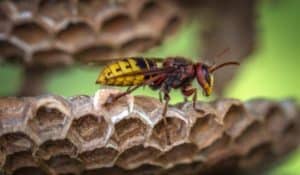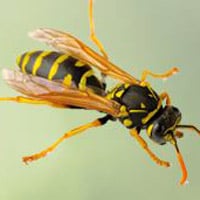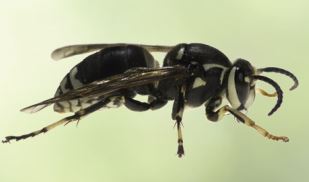Need wasps or yellow jackets control on your property?
Training Guide for Wasps & Yellow Jackets
In western states there are two distinct types of social wasps: yellow jackets and paper wasps. Yellow jackets are by far the most troublesome group. Paper wasps are much less defensive and rarely sting humans. They tend to shy away from human activity except when their nests are located near doors, windows, or other high traffic areas.
Nests of both yellow jacket and paper wasps typically are begun in spring by a single queen who over winters and becomes active when the weather warms. She emerges in late winter/early spring to feed and start a new nest. From spring to midsummer nests are in the growth phase, and the larvae require large amounts of protein. Workers forage mainly for protein at this time (usually in the form of other insects) and for some sugars. By late summer, however, the colonies grow more slowly or cease growth and require large amounts of sugar to maintain the queen and workers. So foraging wasps are particularly interested in sweet things at this time.
Normally, yellow jacket and paper wasp colonies only live one season. In very mild winters or in coastal California south of San Francisco, however, some yellow jacket colonies survive for several years and become quite large.
 The term yellow jacket refers to a number of different species of wasps in the genera Vespula and Dolichovespula (family Vespidae). Included in this group of ground-nesting species are the western yellow jacket, Vespula pensylvanica, which is the most commonly encountered species and is sometimes called the “meat bee,” and seven other species of Vespula. Vespula vulgaris is common in rotted tree stumps at higher elevations and V. germanica (the German yellow jacket) is becoming more common in many urban Western Coastal areas, where it frequently nests in houses such as wall voids and/or attic and crawlspace areas near the vent areas. These wasps tend to be medium sized and black with jagged bands of bright yellow (or white in the case of the aerial-nesting Dolichovespula [=Vespula] maculata) on the abdomen, and have a very short, narrow waist (the area where the thorax attaches to the abdomen).
The term yellow jacket refers to a number of different species of wasps in the genera Vespula and Dolichovespula (family Vespidae). Included in this group of ground-nesting species are the western yellow jacket, Vespula pensylvanica, which is the most commonly encountered species and is sometimes called the “meat bee,” and seven other species of Vespula. Vespula vulgaris is common in rotted tree stumps at higher elevations and V. germanica (the German yellow jacket) is becoming more common in many urban Western Coastal areas, where it frequently nests in houses such as wall voids and/or attic and crawlspace areas near the vent areas. These wasps tend to be medium sized and black with jagged bands of bright yellow (or white in the case of the aerial-nesting Dolichovespula [=Vespula] maculata) on the abdomen, and have a very short, narrow waist (the area where the thorax attaches to the abdomen).
Nests are commonly built in rodent burrows, but other protected cavities, like voids in walls and ceilings of houses, sometimes are selected as nesting sites. Colonies, which are begun each spring by a single reproductive female, can reach populations of between 1,500 and 15,000 individuals, depending on the species. The wasps build a nest of paper made from fibers scraped from wood mixed with saliva. It is built as multiple tiers of vertical cells, similar to nests of paper wasps, but enclosed by a paper envelope around the outside that usually contains a single entrance hole. If the rodent hole is not spacious enough, yellow jackets will increase the size by moistening the soil and digging. Similar behavior inside a house sometimes leads to a wet patch that develops into a hole in a wall or ceiling.
Immature yellow jackets are white, grub like larvae that become white pupae. The pupae develop adult coloring just before they emerge as adult wasps. Immatures are not normally seen unless the nest is torn open or a sudden loss of adult caretakers leads to an exodus of starving larvae.
Aerial-nesting yellow jackets, Dolichovespula arenaria and D. maculata, build paper nests that are attached to the eaves of a building or are hanging from the limb of a tree. The entrance is normally a hole at the bottom of the nest. These aerial nesters do not become scavengers at the end of the season, but they are extremely defensive when their nests are disturbed. Defending D. arenaria sometimes bite and/or sting, simultaneously. Wasp stingers have no barbs and can be used repeatedly, especially when the wasp gets inside clothing. As with any stinging incident, it is best to leave the area of the nest site as quickly as possible if wasps start stinging.
 Paper wasps such as Polistes fuscatus aurifer, P. apachus, and P. dominulus are large (1-inch long), slender wasps with long legs and a distinct, slender waist. Background colors vary, but most western species tend to be golden brown, or darker, with large patches of yellow or red. Preferring to live in or near orchards or vineyards, they hang their paper nests in protected areas, such as under eaves, in attics, or under tree branches or vines. Each nest hangs like an open umbrella from a pedicel (stalk) and has open cells that can be seen from beneath the nest. White, legless, grub like larvae sometimes can be seen from below. Paper wasp nests rarely exceed the size of an outstretched hand and populations vary between 15 to 200 individuals. Most species are relatively unaggressive, but they can be a problem when they nest over doorways or in other areas of human activity, such as fruit trees.
Paper wasps such as Polistes fuscatus aurifer, P. apachus, and P. dominulus are large (1-inch long), slender wasps with long legs and a distinct, slender waist. Background colors vary, but most western species tend to be golden brown, or darker, with large patches of yellow or red. Preferring to live in or near orchards or vineyards, they hang their paper nests in protected areas, such as under eaves, in attics, or under tree branches or vines. Each nest hangs like an open umbrella from a pedicel (stalk) and has open cells that can be seen from beneath the nest. White, legless, grub like larvae sometimes can be seen from below. Paper wasp nests rarely exceed the size of an outstretched hand and populations vary between 15 to 200 individuals. Most species are relatively unaggressive, but they can be a problem when they nest over doorways or in other areas of human activity, such as fruit trees.
 Hornets are a social wasp related to the yellow jackets and paper wasps. These all live in colonies similar to those of honey bees and ants. The hornet colony is contained inside the nest constructed of paper-like material made from chewed wood fibers mixed with saliva. The nest is composed of 3 or 4 tiers of combs within a thick, multilayered outer shell. A single opening at the bottom allows the hornets to fly in and out. Hornet nests are usually located in wooded areas, attached to a tree branch, but may be attached to shrubs, utility poles or house siding.
Hornets are a social wasp related to the yellow jackets and paper wasps. These all live in colonies similar to those of honey bees and ants. The hornet colony is contained inside the nest constructed of paper-like material made from chewed wood fibers mixed with saliva. The nest is composed of 3 or 4 tiers of combs within a thick, multilayered outer shell. A single opening at the bottom allows the hornets to fly in and out. Hornet nests are usually located in wooded areas, attached to a tree branch, but may be attached to shrubs, utility poles or house siding.
Bald faced hornets are large, black insects about 7/8 of an inch long with white to cream-colored markings on the front of the head and at the end of the abdomen. Like all wasps, bees and ants, hornets have a complete life cycle of four stages: egg, larva, pupa and adult. The larva is a legless grub reared within cells in the nest. Hornets are beneficial predators that feed on other insects, particularly filth flies and blow flies.
A colony of social wasps (hornets, yellow jackets and paper wasps) lasts only 1 year. Each nest is built from scratch each year and the previous year’s nest can not be reused. Queens are the only members of the colony able to survive the winter. In April or May, each queen selects a suitable location, constructs a small nest and begins raising sterile daughter offspring. These workers take over the duties of enlarging and maintaining the nest, foraging for food and caring for the offspring while the queen functions only to produce more eggs.
At first colony growth is slow, but growth increases rapidly by mid-summer as successive broods of workers emerge. Peak worker population is 100 to 400 hornets by the end of the summer. In the fall, males and new queens are produced. These leave the nest; mate and the fertilized queens hibernate. The remainder of the workers, the old queen and the males die of old age or freezing temperatures.
The size of a hornet’s nest and the hornets’ reputation is often sufficient to alarm people. Fortunately, the aggressiveness of hornets does not match their appearance, although disturbing a nest or threatening an individual wasp will result in stings. Hornets are very protective of their colony and will usually attack if someone approaches within 3 feet of the nest. A nest located in a “high traffic” area such as along walks or near doorways justifies control to reduce the threat of being stung. Nests away from human activity should be left undisturbed.
 Bald faced hornet colonies are relatively easy to control using one of the several insecticidal aerosol products specifically designed for this purpose. A special nozzle and propellant system spray a thin stream of insecticide up to 20 feet.
Bald faced hornet colonies are relatively easy to control using one of the several insecticidal aerosol products specifically designed for this purpose. A special nozzle and propellant system spray a thin stream of insecticide up to 20 feet.
Colonies should be exterminated at night, if possible, when workers are least active and the maximum number is at the nest. Safety precautions include protective clothing such as a thick jacket, long pants tucked into socks, gloves and a hat.
Spray into the entrance hole at first and then thoroughly wet the nest. Do not remove the nest until all wasps are dead. This may take a day or two as some foraging workers may not have been in the nest at the time of treatment. Follow all labeled directions on the insecticide.
 Bumble bees are considered to be beneficial insects because they pollinate crops and plants. They are very social bees and live in large “families”. Bumble bees can sting more than once because their stingers are smooth and don’t get caught in the skin when they fly away unlike honey bees which have a barbed stinger that sticks in the skin when they fly away. Diet: Worker bees gather both pollen and nectar from flowers to feed to the larvae and other members of the colony. Habitat: Bumble bees often nest in the ground, but can be found above ground around patio areas or decks. They will sometimes build their nests in attics or under roof beams or wall voids. If disturbed, bumble bees will buzz in a loud volume, and they will aggressively defend their nests. Impact: As part of the aggressive defense of their nests, bumble bees will chase nest invaders for long distances. The bumble bee sting is one of the most painful stings. Swelling and irritation can last for days after you are actually stung. Prevention: Bumble bees can be prevented through inspection of potential nesting areas and removal of potential nesting materials. Because bumble bees will sting when threatened, homeowners are advised not to address the infestation themselves. A pest management professional or beekeeper should be called in to help.
Bumble bees are considered to be beneficial insects because they pollinate crops and plants. They are very social bees and live in large “families”. Bumble bees can sting more than once because their stingers are smooth and don’t get caught in the skin when they fly away unlike honey bees which have a barbed stinger that sticks in the skin when they fly away. Diet: Worker bees gather both pollen and nectar from flowers to feed to the larvae and other members of the colony. Habitat: Bumble bees often nest in the ground, but can be found above ground around patio areas or decks. They will sometimes build their nests in attics or under roof beams or wall voids. If disturbed, bumble bees will buzz in a loud volume, and they will aggressively defend their nests. Impact: As part of the aggressive defense of their nests, bumble bees will chase nest invaders for long distances. The bumble bee sting is one of the most painful stings. Swelling and irritation can last for days after you are actually stung. Prevention: Bumble bees can be prevented through inspection of potential nesting areas and removal of potential nesting materials. Because bumble bees will sting when threatened, homeowners are advised not to address the infestation themselves. A pest management professional or beekeeper should be called in to help.
Mud daubers are black and yellow, thread-waisted, solitary wasps that build a hard mud nest, usually on ceilings and walls or in attics, attended by a single female wasp. They belong to the family Sphecidae and are not social wasps but may be confused with them. They do not defend their nests and rarely sting. During winter, you can safely remove the nests without spraying.
 Certain species of bees die after stinging. That is because their stingers are attached to their
Certain species of bees die after stinging. That is because their stingers are attached to their
abdomen, and have little barbs or hooks on them. When the bee tries to fly away after stinging something, part of the abdomen is ripped away and it dies. Bees make honey to feed their young and so they have something to eat during the winter. Beekeepers use smoke to calm bees when they are collecting honey or relocating a hive.
General Information
Honeybees live in large “families” and are found all over the world. The honeybee is the only social insect whose colony can survive many years. That is because they huddle together and eat honey to keep themselves alive during the winter months.
Honeybees pollinate more than 100 crops in the U.S. Their wings flap 11,000 times per minute, which is why it sounds like they are “buzzing”. Honeybees can only sting once, because their stingers are barbed and tear off when they try to get away.
Diet
Honeybees produce honey from pollen and nectar of the plants they pollinate. They store the honey in honeycombs in their nests, which they use to feed their young in colder months.
Habitat
Honeybee nests vary in size. They typically build their nests in tree crevices, but will occasionally build nests in attics or chimneys.
Impact
Honeybees do sting, but they only sting once. The sting can be extremely painful if the stinger is not immediately removed from the skin. Persons allergic to insect stings will have a more severe reaction.
Prevention Tips
During the summer time months a good way to help prevent yellow jackets, wasps and bees from infesting your home is to seal up any small gaps around your exterior home such as: eaves, utility penetrations to exterior siding etc… You can also have a licensed pest control company provide a general prevention spray around the exterior homes eaves areas, siding/foundation areas and utility penetration areas at exterior siding areas to help prevent wasp & bee infestations to your home. You can also purchase yellow jacket traps at your local hardware store to hang outside your home and prevent potential yellow jacket infestations to your home.
130+ Reviews, avg 4.7 stars
Get A Quote Today
When you contact us for an estimate, our certified technicians will inspect your home and provide you with a detailed plan to eliminate those unwanted invaders. They will also discuss treatment options to ensure you are informed before they take any action.
Call our staff today at 425-398-7365. We will provide you with peace of mind, valuable information, and affordable service. We’ll get back to you within 1 business day.




